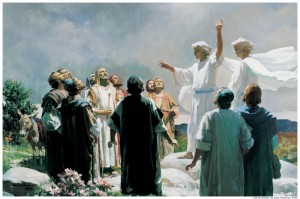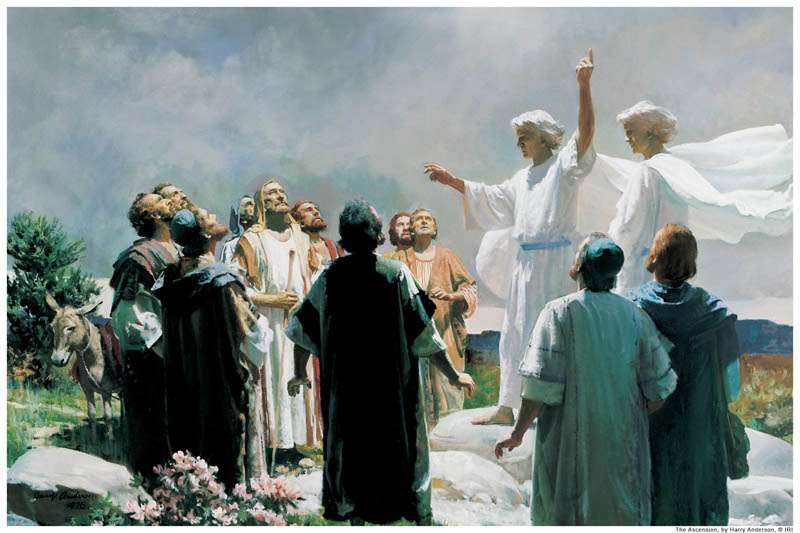Early in the morning on the day after the Sabbath a mighty work was at hand. We know nothing of what occurred inside the Garden Tomb, testifying of the sacredness of the actual event, only that soon afterward the earth shook and two angels rolled away the great stone from the mouth of the tomb.
 Two guards appointed by Pilate had been keeping watch. The chief scribes and Pharisees were so concerned with Christ’s prophecies about rising again they didn’t want to take any chances His followers would try any tricks (Matthew 27:62-64). In doing so they unintentionally gave quite a witness to the heavenly events. The two guards fainted at the sight.
Two guards appointed by Pilate had been keeping watch. The chief scribes and Pharisees were so concerned with Christ’s prophecies about rising again they didn’t want to take any chances His followers would try any tricks (Matthew 27:62-64). In doing so they unintentionally gave quite a witness to the heavenly events. The two guards fainted at the sight.
Around this same time a group of women, many of whom had been disciples (devoted followers) of Jesus since He began His ministry in Galilee, were on their way to the tomb to anoint His body in the proper oils, thus giving Him the burial Jewish law required. They must have presented a desolate sight, grieving for the loss of their beloved leader and teacher.
The time line here gets a little fuzzy. Seeing the open tomb Mary Magdalene fears the worst. She runs to find Simon Peter, telling him, “They have taken away the Lord out of the sepulchre, and we know not where they have laid him” (John 20:2). Mary believed someone had taken the Lord’s body, unwilling to let Him rest in peace but causing mischief even in His death.
While this was going on the women had looked into the tomb and saw two angels within (We discover there were two angels through the inspired translation of Joseph Smith in the King James Version of the Bible). “Why seek ye the living among the dead?” the heavenly visitors ask (Luke 24:5). The women are told to go immediately and tell everyone Christ had indeed risen.
No one believed them at first. In their grief and agony at such a loss, it isn’t too hard to imagine their doubt. As the women went on proclaiming the good news Simon Peter and John raced to see the tomb for themselves. Mary Magdalene was perhaps forgotten in their wonder at the sight of Christ’s burial clothes left undisturbed on the stone bench (by this time it seems the angels had left). Only then did they realize what had happened: Jesus the Christ had been resurrected!
Mary Magdalene had not come to this knowledge. In her mind she could not get past grieving over the loss of the Lord. She still thought someone had taken Him away. James E. Talmage, an apostle in the Church of Jesus Christ of Latter-day Saints (nicknamed the Mormon Church), describes Mary as a noble woman and devoted soul.
“Mary became one of the closest friends Christ had among women; her devotion to Him as her Healer and as the One whom she adored as the Christ was unswerving; she stood close by the cross while other women tarried afar off in the time of His mortal agony; she was among the first at the sepulchre on the resurrection morning” (Talmage, James E., Jesus the Christ, the Church of Jesus Christ of Latter-day Saints, 1981, p.264-65).
Only when she found herself alone at the tomb did she look inside. Once again there were two angels who asked the grieving woman, “Why weepest thou?” to which she answered, “Because they have taken away my Lord, and I know not where they have laid him” (John 20:13). She turned away from the tomb only to be met with the presence of another. She assumed he was the gardener, or caretaker of the garden. She also assumed he must know what had happened to the occupant of the tomb. When she is against asked why she is crying she responds, “Sir, if thou have borne him hence, tell me where thou hast laid him, and I will take him away (John 20:15). She never calls Him by name.
Here is one of, in my eyes, the most beautiful events recorded in history. Perhaps it speaks to my heart of how the voice of someone we love, whether it be a treasured friend or family member, can be recognized even in the face of death. The man spoke just one word, “Mary.”
“One word from His living lips changed her agonized grief into ecstatic joy…. The voice, the tone, the tender accent she had heard and loved in the earlier days lifted her from the despairing depths into which she had sunk. She turned, and saw the Lord” (Talmage, James E., Jesus the Christ, the Church of Jesus Christ of Latter-day Saints, 1981, p.681).
In her joy she reached out. Christ beckoned for her to pause. “Touch me not; for I am not yet ascended to my Father: but go to my brethren, and say unto them, I ascend to my Father, and your Father; and to my God, and your God” (John 20:17).
Even as a resurrected being, when Christ could have stood in glory of what He had accomplished, He instead turns our attention to the Father.
Mary did what was asked of her, though again no one believed. How could they, when she hadn’t been able to understand until she saw the living Christ for herself? To Mary’s testimony came that of the other women. Once Christ had visited with our Father, He came to them, and then to others.
Christ was risen. All that He taught and prophesied had come to pass. He truly was the Messiah, the Redeemer of all mankind.


